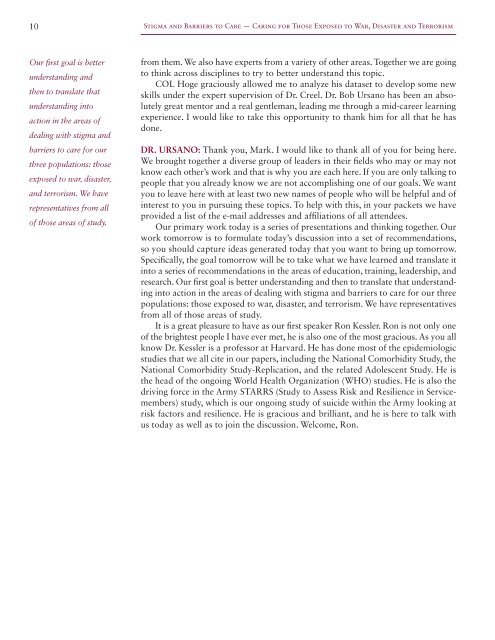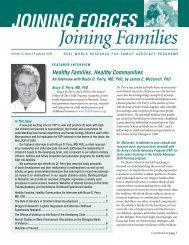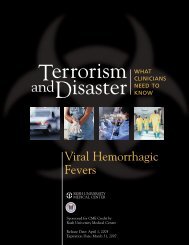stigma and barriers to care - Uniformed Services University of the ...
stigma and barriers to care - Uniformed Services University of the ...
stigma and barriers to care - Uniformed Services University of the ...
You also want an ePaper? Increase the reach of your titles
YUMPU automatically turns print PDFs into web optimized ePapers that Google loves.
10<br />
Stigma <strong>and</strong> Barriers <strong>to</strong> Care — Caring for Those Exposed <strong>to</strong> War, Disaster <strong>and</strong> Terrorism<br />
Our first goal is better<br />
underst<strong>and</strong>ing <strong>and</strong><br />
<strong>the</strong>n <strong>to</strong> translate that<br />
underst<strong>and</strong>ing in<strong>to</strong><br />
action in <strong>the</strong> areas <strong>of</strong><br />
dealing with <strong>stigma</strong> <strong>and</strong><br />
<strong>barriers</strong> <strong>to</strong> <strong>care</strong> for our<br />
three populations: those<br />
exposed <strong>to</strong> war, disaster,<br />
<strong>and</strong> terrorism. We have<br />
representatives from all<br />
<strong>of</strong> those areas <strong>of</strong> study.<br />
from <strong>the</strong>m. We also have experts from a variety <strong>of</strong> o<strong>the</strong>r areas. Toge<strong>the</strong>r we are going<br />
<strong>to</strong> think across disciplines <strong>to</strong> try <strong>to</strong> better underst<strong>and</strong> this <strong>to</strong>pic.<br />
COL Hoge graciously allowed me <strong>to</strong> analyze his dataset <strong>to</strong> develop some new<br />
skills under <strong>the</strong> expert supervision <strong>of</strong> Dr. Creel. Dr. Bob Ursano has been an absolutely<br />
great men<strong>to</strong>r <strong>and</strong> a real gentleman, leading me through a mid‐<strong>care</strong>er learning<br />
experience. I would like <strong>to</strong> take this opportunity <strong>to</strong> thank him for all that he has<br />
done.<br />
DR. URSANO: Thank you, Mark. I would like <strong>to</strong> thank all <strong>of</strong> you for being here.<br />
We brought <strong>to</strong>ge<strong>the</strong>r a diverse group <strong>of</strong> leaders in <strong>the</strong>ir fields who may or may not<br />
know each o<strong>the</strong>r’s work <strong>and</strong> that is why you are each here. If you are only talking <strong>to</strong><br />
people that you already know we are not accomplishing one <strong>of</strong> our goals. We want<br />
you <strong>to</strong> leave here with at least two new names <strong>of</strong> people who will be helpful <strong>and</strong> <strong>of</strong><br />
interest <strong>to</strong> you in pursuing <strong>the</strong>se <strong>to</strong>pics. To help with this, in your packets we have<br />
provided a list <strong>of</strong> <strong>the</strong> e-mail addresses <strong>and</strong> affiliations <strong>of</strong> all attendees.<br />
Our primary work <strong>to</strong>day is a series <strong>of</strong> presentations <strong>and</strong> thinking <strong>to</strong>ge<strong>the</strong>r. Our<br />
work <strong>to</strong>morrow is <strong>to</strong> formulate <strong>to</strong>day’s discussion in<strong>to</strong> a set <strong>of</strong> recommendations,<br />
so you should capture ideas generated <strong>to</strong>day that you want <strong>to</strong> bring up <strong>to</strong>morrow.<br />
Specifically, <strong>the</strong> goal <strong>to</strong>morrow will be <strong>to</strong> take what we have learned <strong>and</strong> translate it<br />
in<strong>to</strong> a series <strong>of</strong> recommendations in <strong>the</strong> areas <strong>of</strong> education, training, leadership, <strong>and</strong><br />
research. Our first goal is better underst<strong>and</strong>ing <strong>and</strong> <strong>the</strong>n <strong>to</strong> translate that underst<strong>and</strong>ing<br />
in<strong>to</strong> action in <strong>the</strong> areas <strong>of</strong> dealing with <strong>stigma</strong> <strong>and</strong> <strong>barriers</strong> <strong>to</strong> <strong>care</strong> for our three<br />
populations: those exposed <strong>to</strong> war, disaster, <strong>and</strong> terrorism. We have representatives<br />
from all <strong>of</strong> those areas <strong>of</strong> study.<br />
It is a great pleasure <strong>to</strong> have as our first speaker Ron Kessler. Ron is not only one<br />
<strong>of</strong> <strong>the</strong> brightest people I have ever met, he is also one <strong>of</strong> <strong>the</strong> most gracious. As you all<br />
know Dr. Kessler is a pr<strong>of</strong>essor at Harvard. He has done most <strong>of</strong> <strong>the</strong> epidemiologic<br />
studies that we all cite in our papers, including <strong>the</strong> National Comorbidity Study, <strong>the</strong><br />
National Comorbidity Study-Replication, <strong>and</strong> <strong>the</strong> related Adolescent Study. He is<br />
<strong>the</strong> head <strong>of</strong> <strong>the</strong> ongoing World Health Organization (WHO) studies. He is also <strong>the</strong><br />
driving force in <strong>the</strong> Army STARRS (Study <strong>to</strong> Assess Risk <strong>and</strong> Resilience in Servicemembers)<br />
study, which is our ongoing study <strong>of</strong> suicide within <strong>the</strong> Army looking at<br />
risk fac<strong>to</strong>rs <strong>and</strong> resilience. He is gracious <strong>and</strong> brilliant, <strong>and</strong> he is here <strong>to</strong> talk with<br />
us <strong>to</strong>day as well as <strong>to</strong> join <strong>the</strong> discussion. Welcome, Ron.




